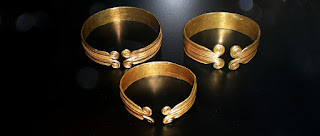LOST IN TIME
1. Series: What Viking wouldn´t tell you
Linn Duachaill
About Vikings we can generally say, that they were the
conquerors, who sailed the seas and oceans and observed different corners of
the world. Howerver, many may not know that their traces can be found also in
Ireland. The first attacks began in 795, and in the following years they
plundered and destroyed territory. However, over the time the Vikings began to
settle in the country to deal with the local population and of course built
cities and forts.
In Annals of Ulster, where we can find information
about medieval Ireland, is written that in year 841 „There was a naval camp at Linn Duachaill from which the peoples
and churches of Tethba were plundered. There was a naval camp at Duiblinn
from which the Laigin and the Uí Néill were plundered, both states and
churches, as far as Sliab Bladma.“
From naval camp Duiblinn became Dublin, but about
Linn Duachaill people thought that it is only some kind of mythical place,
because all the tracks, which led to it were LOST IN TIME. So, stories about it could be for longer time found
only in stories of people. As stated Jaroslav Petr in village Annagassan „has been for a long time rumored that
near the village was once the Viking settlement.“
It is true, that in the area have been found various
artifacts, but basically there were no more tracks, which would lead directly to
the discovery of this place or its remains. But as Petr adds „systematic quest for Linn Duachaill launched
several years ago by a local filmmaker Ruth Cassidy with archaeologist
Mark Clinton. For a long time they were unsuccessful and slowly were ready
to abandon the project. But, finally were lucky. A few miles up the river
Glyde found a place where the flat shore develop an ideal port and place for
the construction and repair of ships.“
Furthermore, as stated Conor Macauley researches
found „a huge fortified settlement up to
150 acres in size, established by 841AD where the Vikings built and repaired
their ships, traded and raided into the surrounding countryside.“
Of course, also Vikings could be attacked, and they
were often building fortifications that would protect them. In this case, as
reported Conor Macauley, historian Micheál McKeown said that they „built a heavily defended position by digging
a long trench between the river and the Irish Sea.“
We can say that at that time was Linn Duachaill an
important fortress, which has been used for many years. Similarly, we can ask
why such a place actually settlers leaved? Apparently the second naval
camp Duiblinn, present Dublin, grow faster because it was a more prominent
place and subsequently people moved there, or as informed Heritagedaily it was
„possibly because it lacked continuous
access to the sea.“
Sources:
Anon. The Annals of
Ulster. UCC: 2015. [online]. [cited 3.
1.2015]. Available: http://www.ucc.ie/celt/online/T100001A/
Conor
Macauley. Linn Duchaill: Ireland´s
unlikely Viking capital. BBC: 2011. [online]. [cited 3. 1.2015]. Available: http://www.bbc.co.uk/news/uk-northern-ireland-15430864
Heritage
Daily. Viking longphort of Linn Duachaill
confirmed through Radio Carbon Dating. HERITAGEDAILY: 2011. [online]. [cited 3.
1.2015]. Available: http://www.heritagedaily.com/2011/10/viking-longphort-of-linn-duachaill-confirmed-through-radion-carbon-dating/11930
Jaroslav
Petr. Ztracené město Vikingů objeveno. VTM.E15:
n.d. [online]. [cited
3. 1.2015]. Available: http://vtm.e15.cz/aktuality/ztracene-mesto-vikingu-objeveno


Comments
Post a Comment
Have you heard about that? / Do you have some personal story about that?